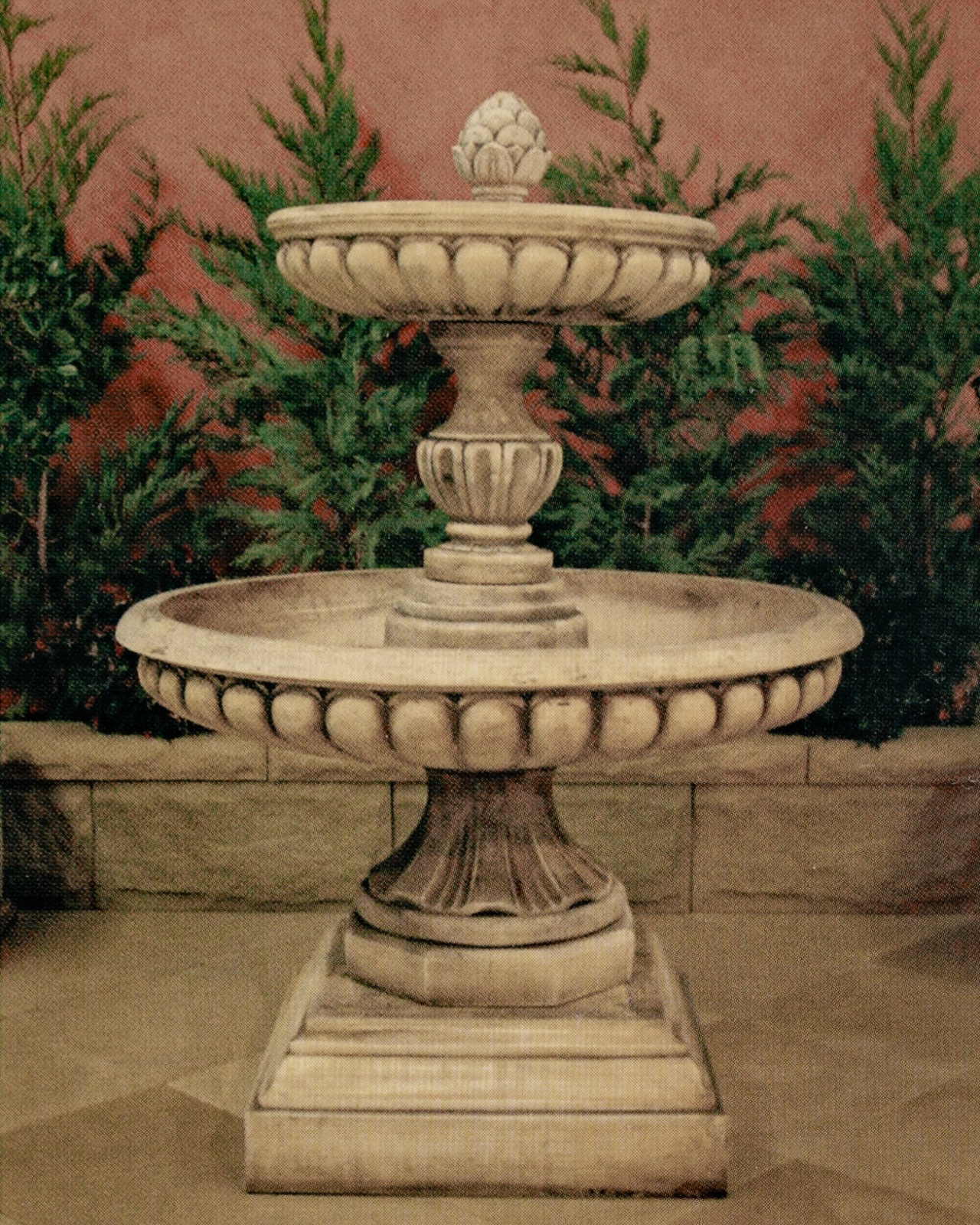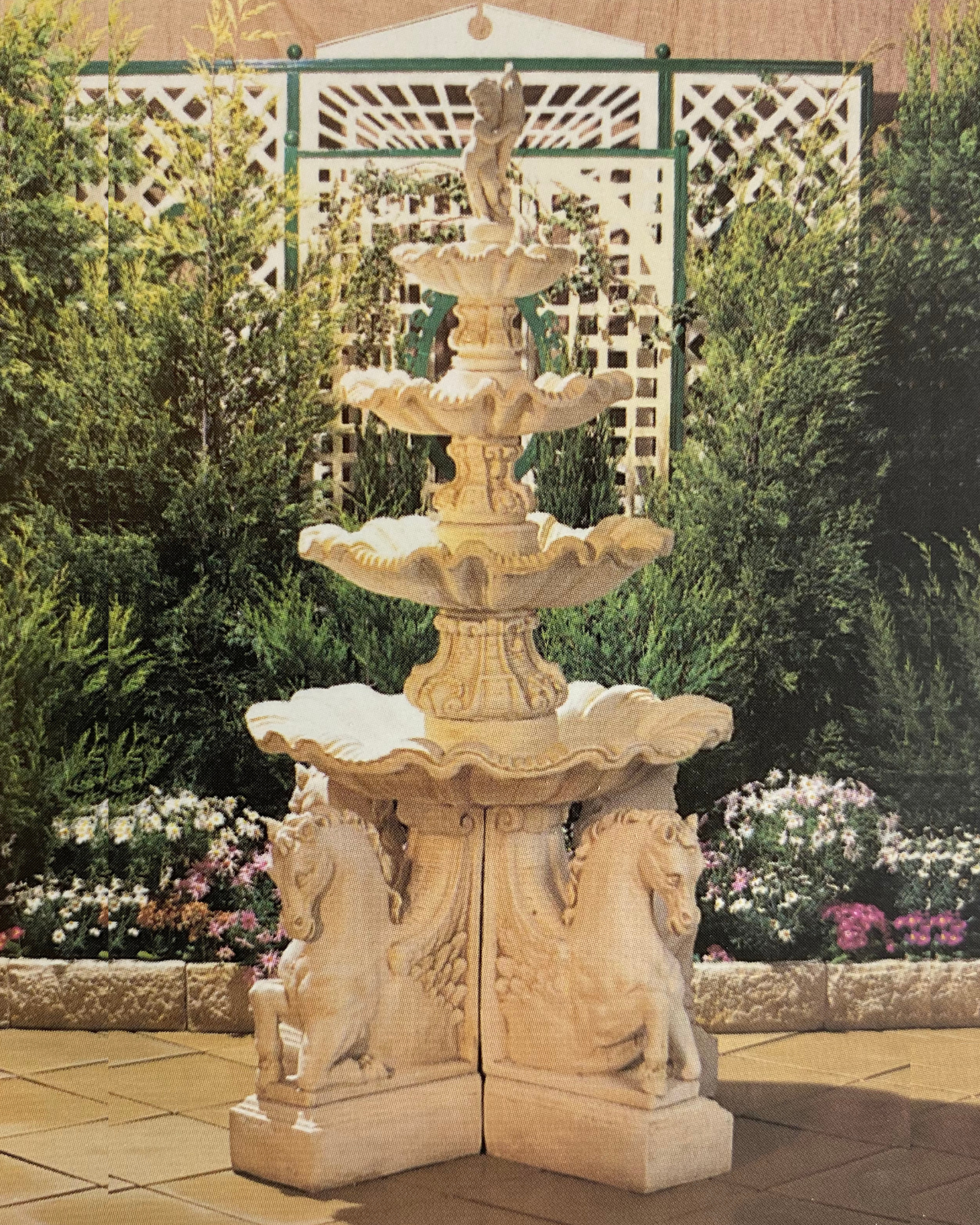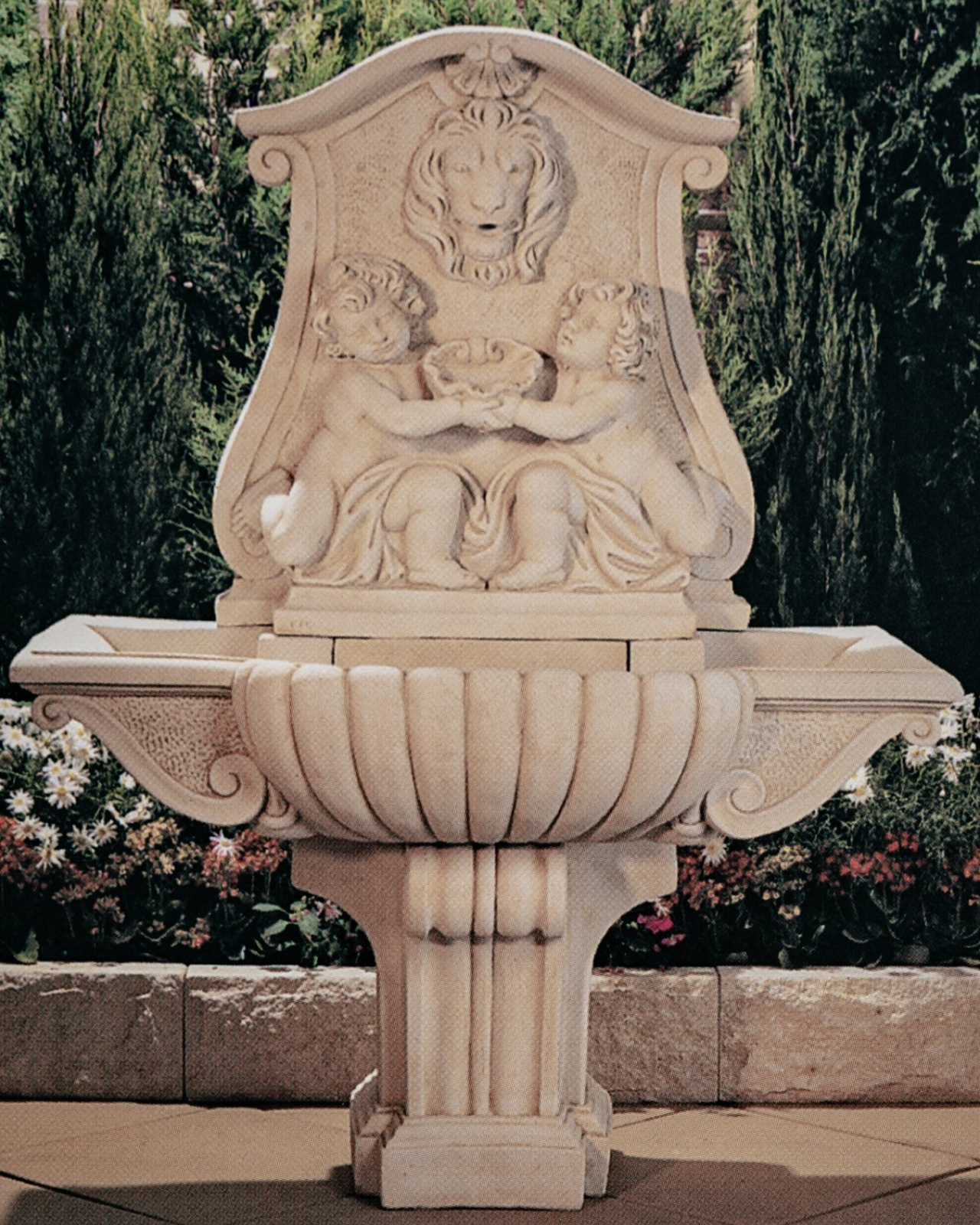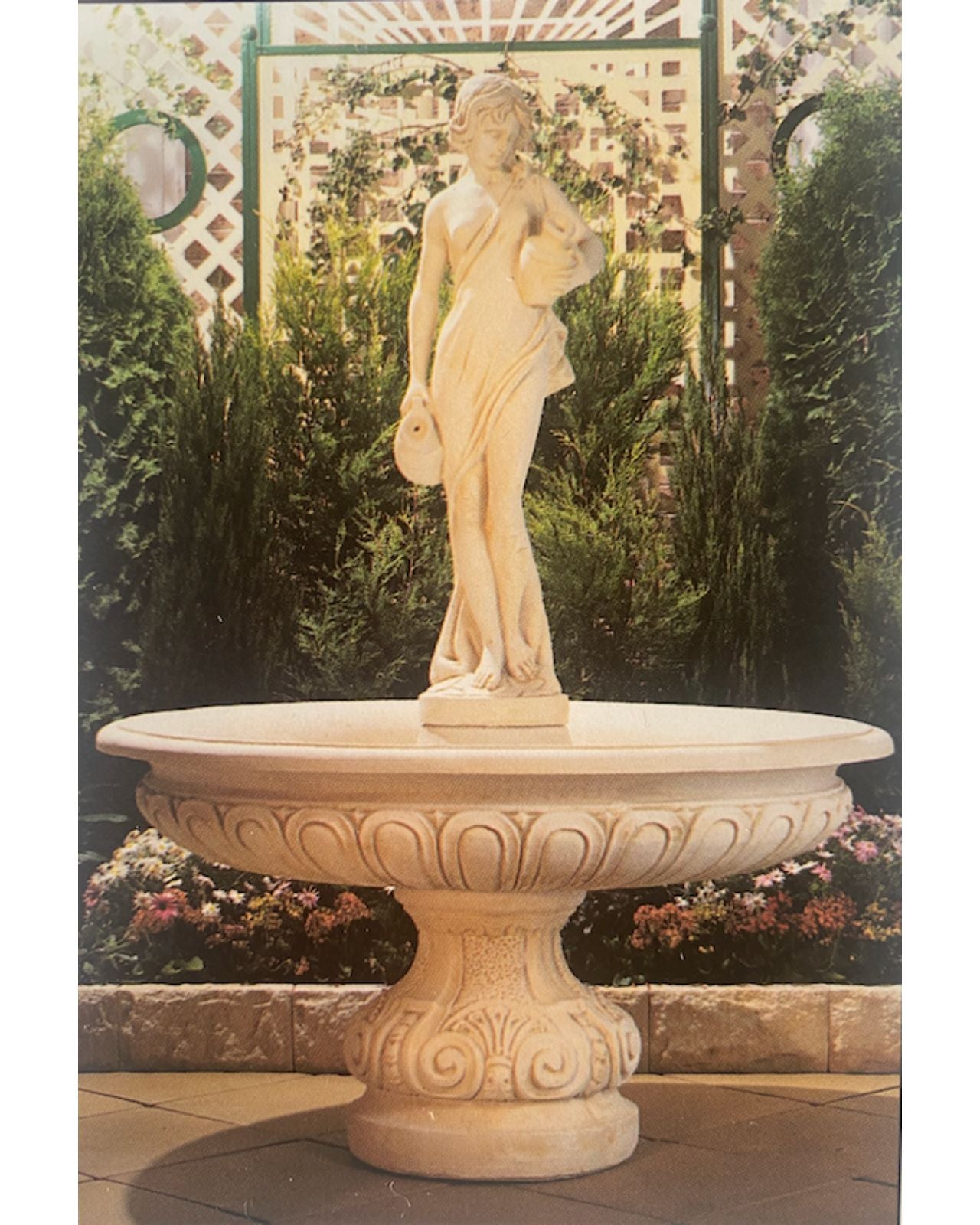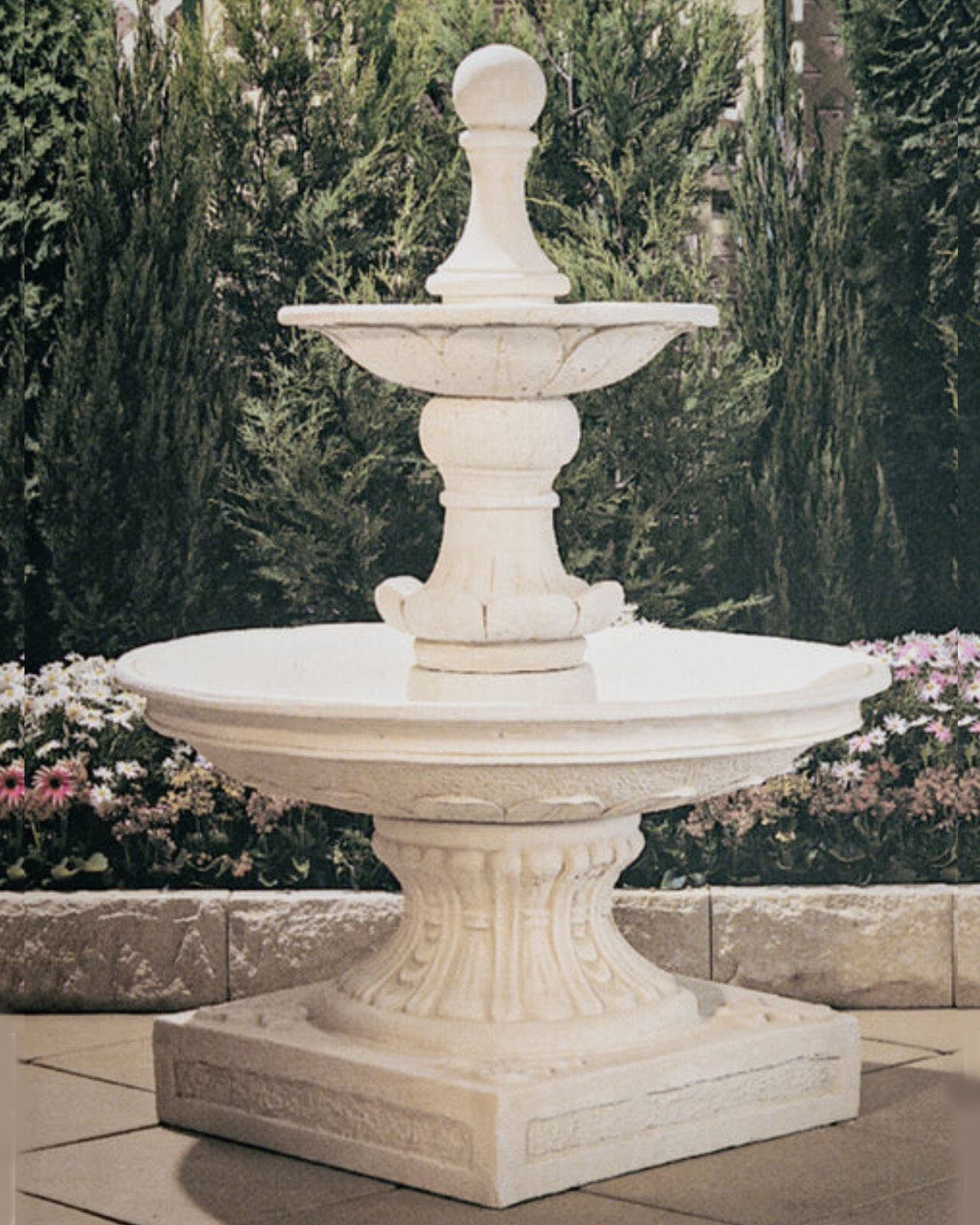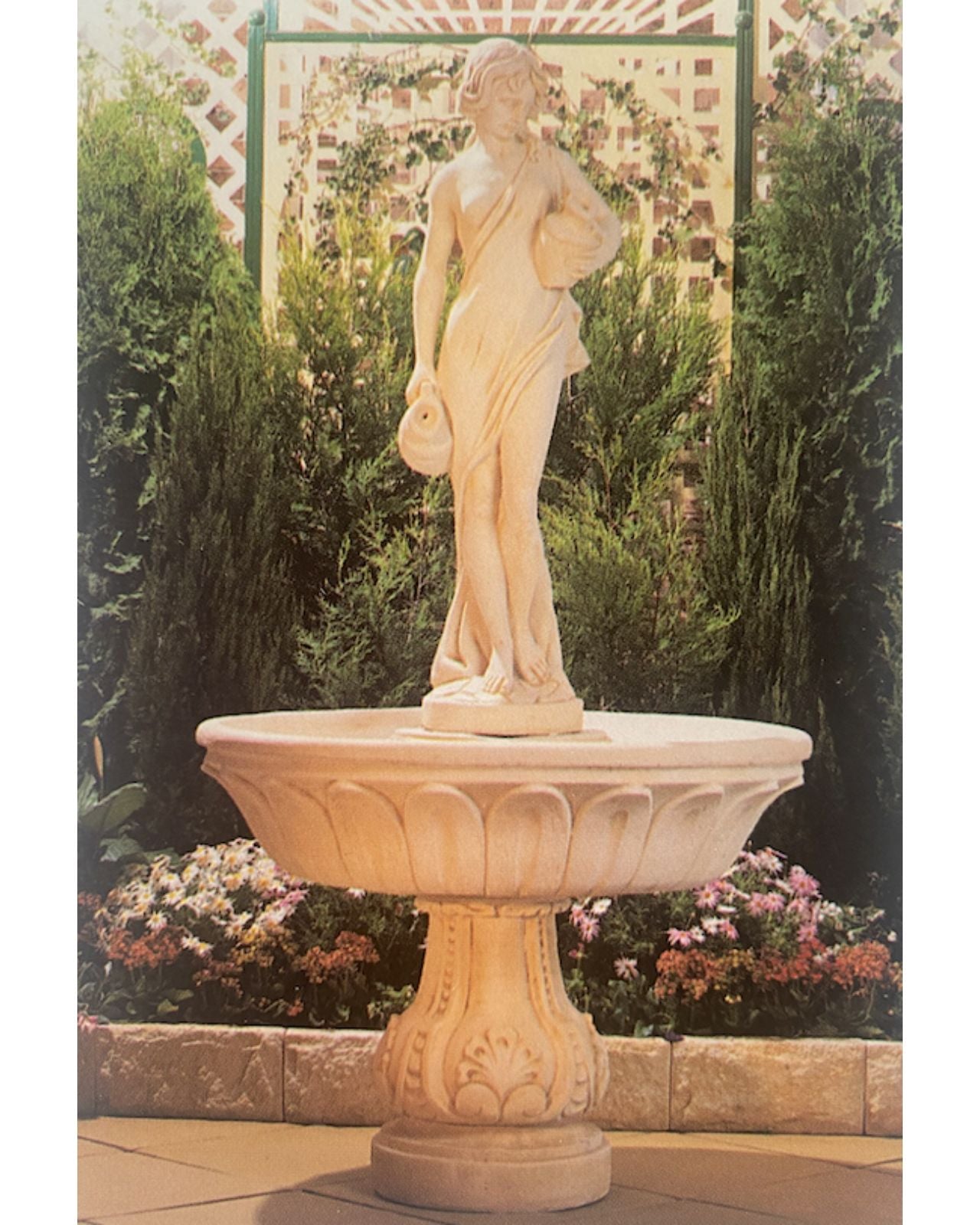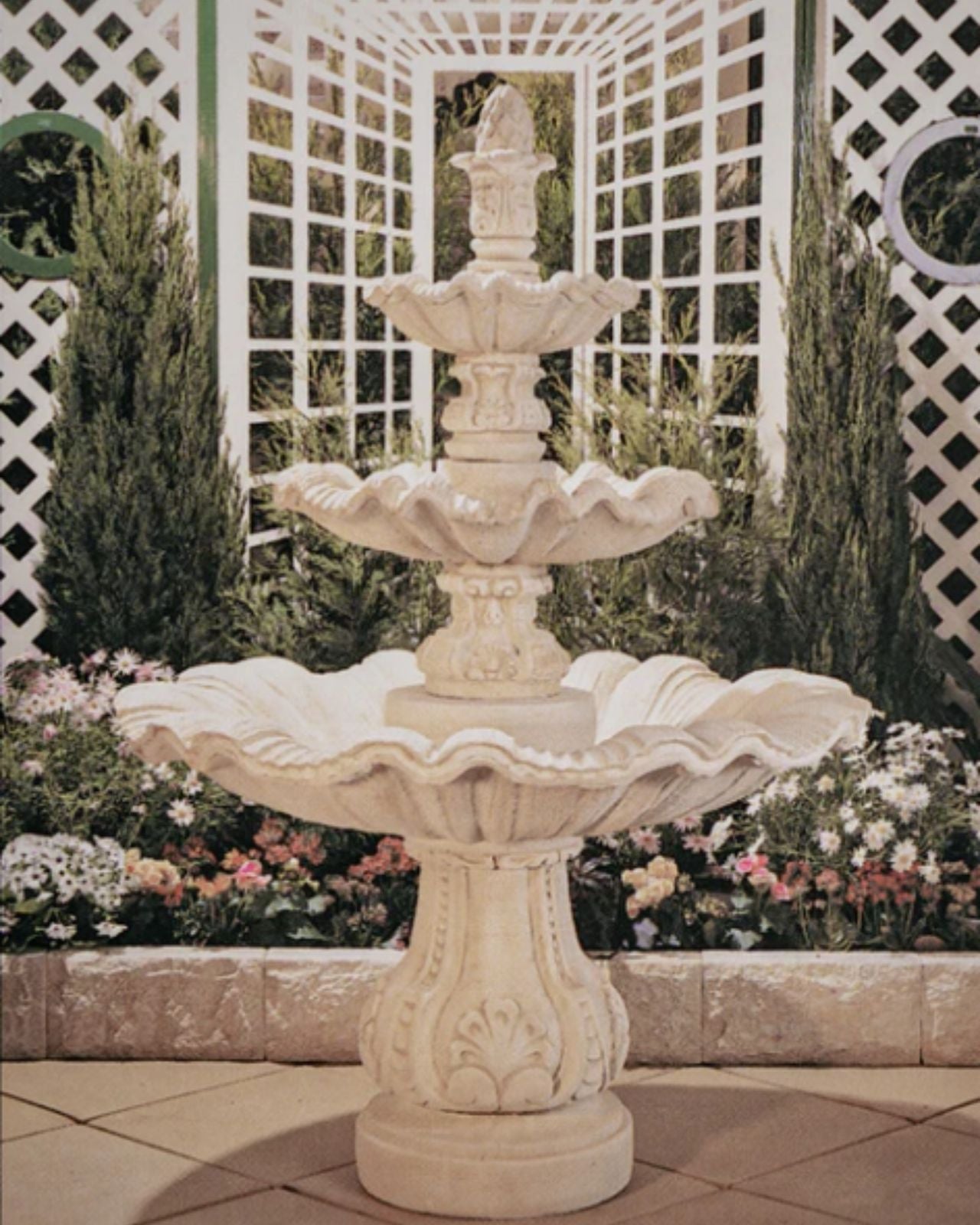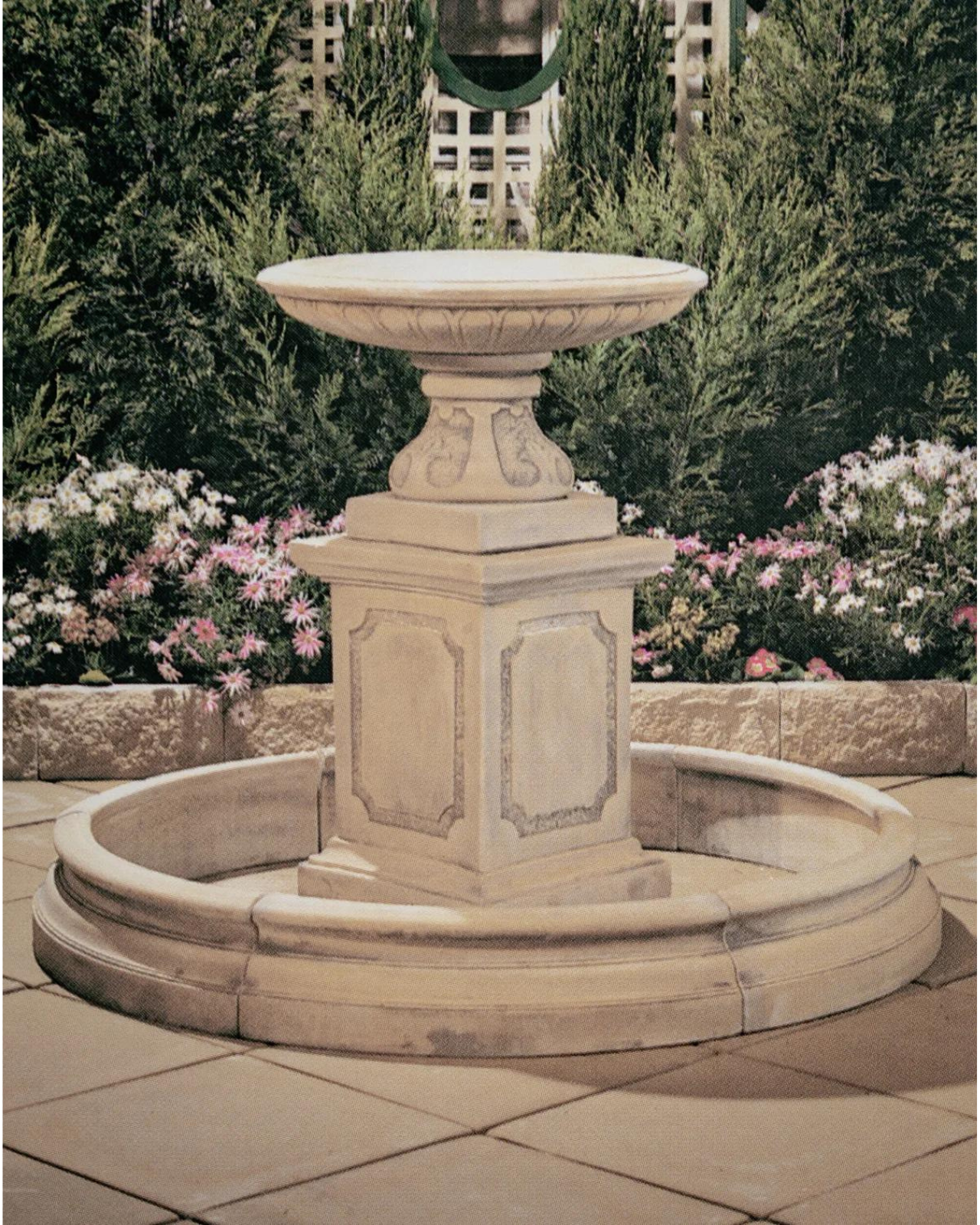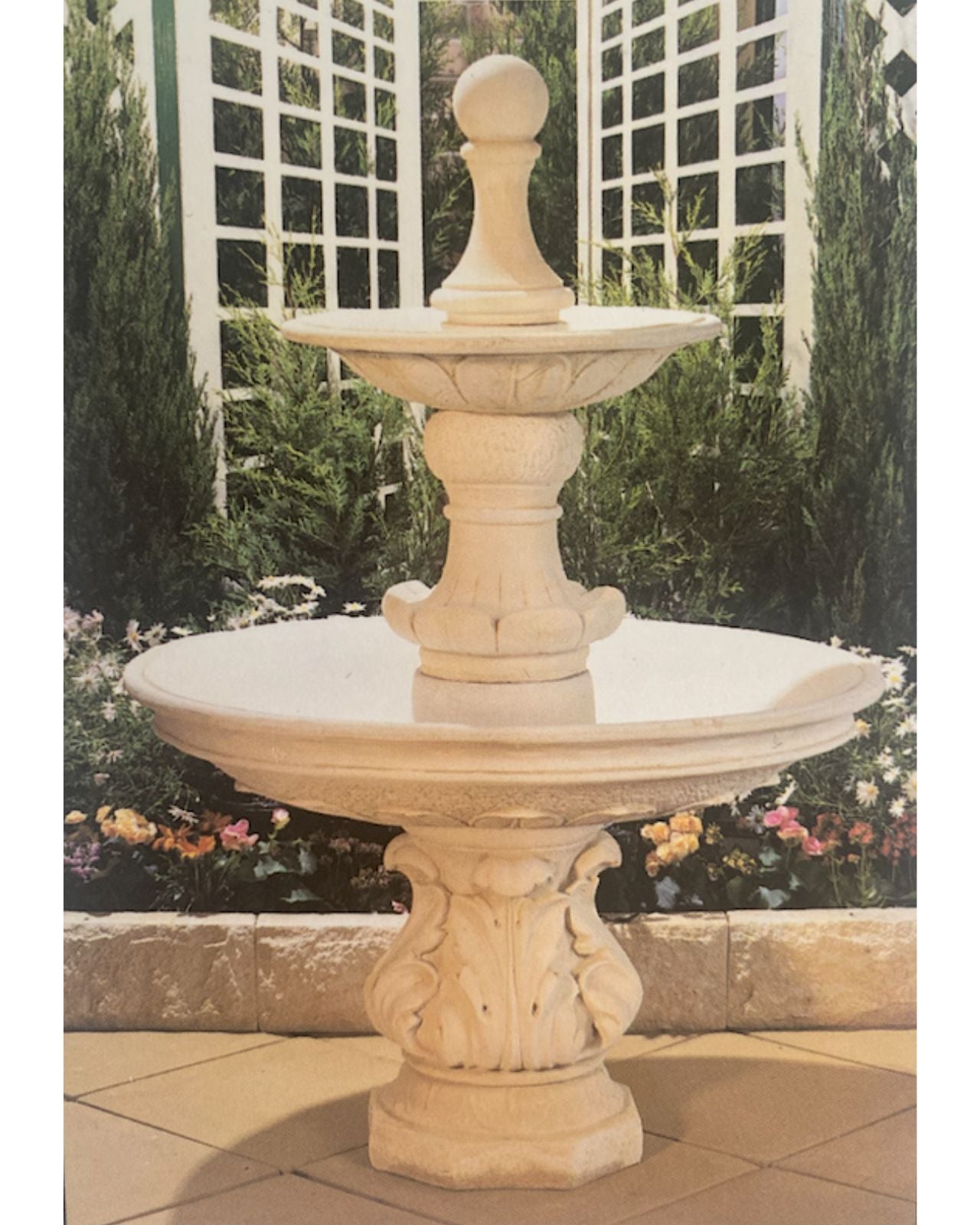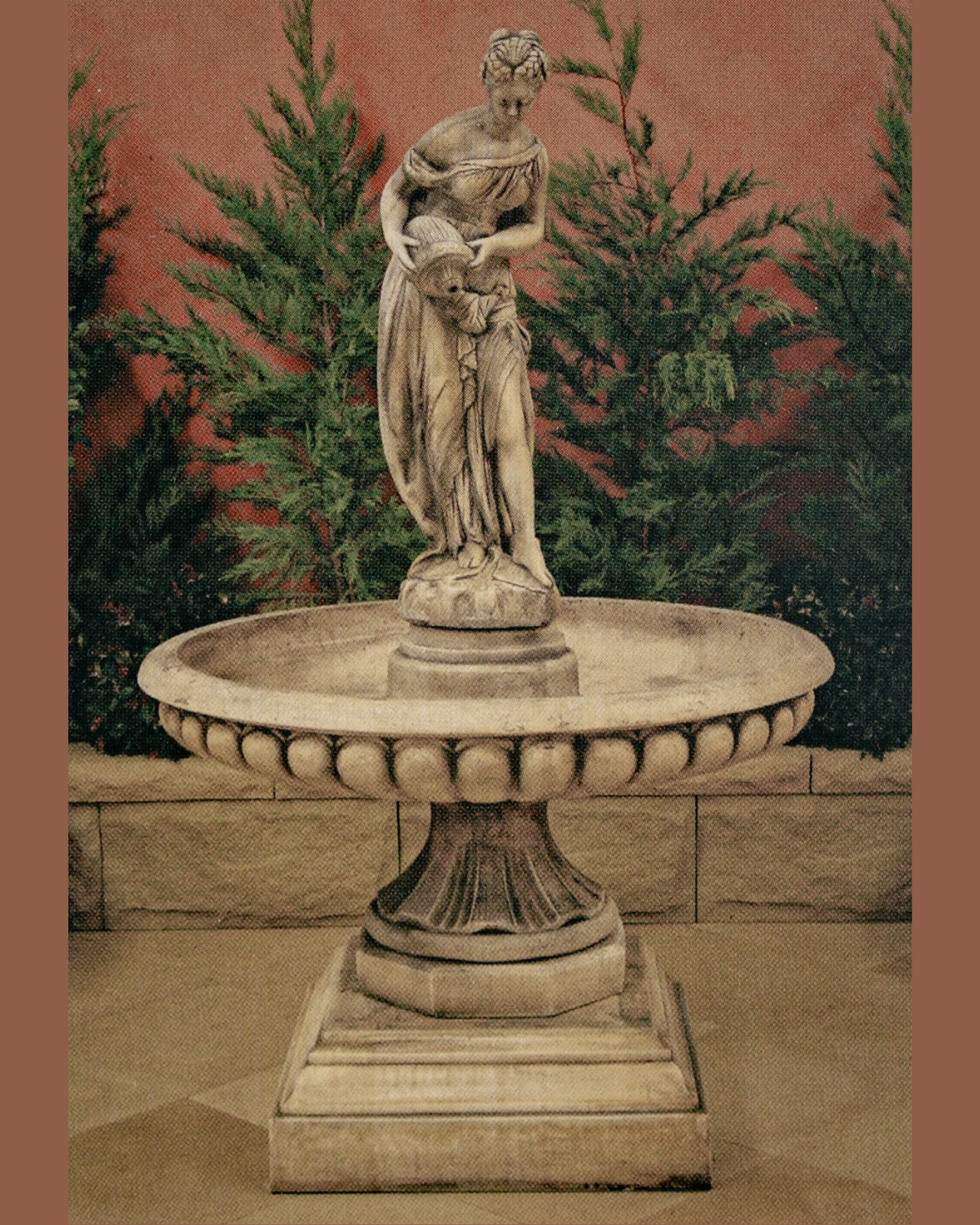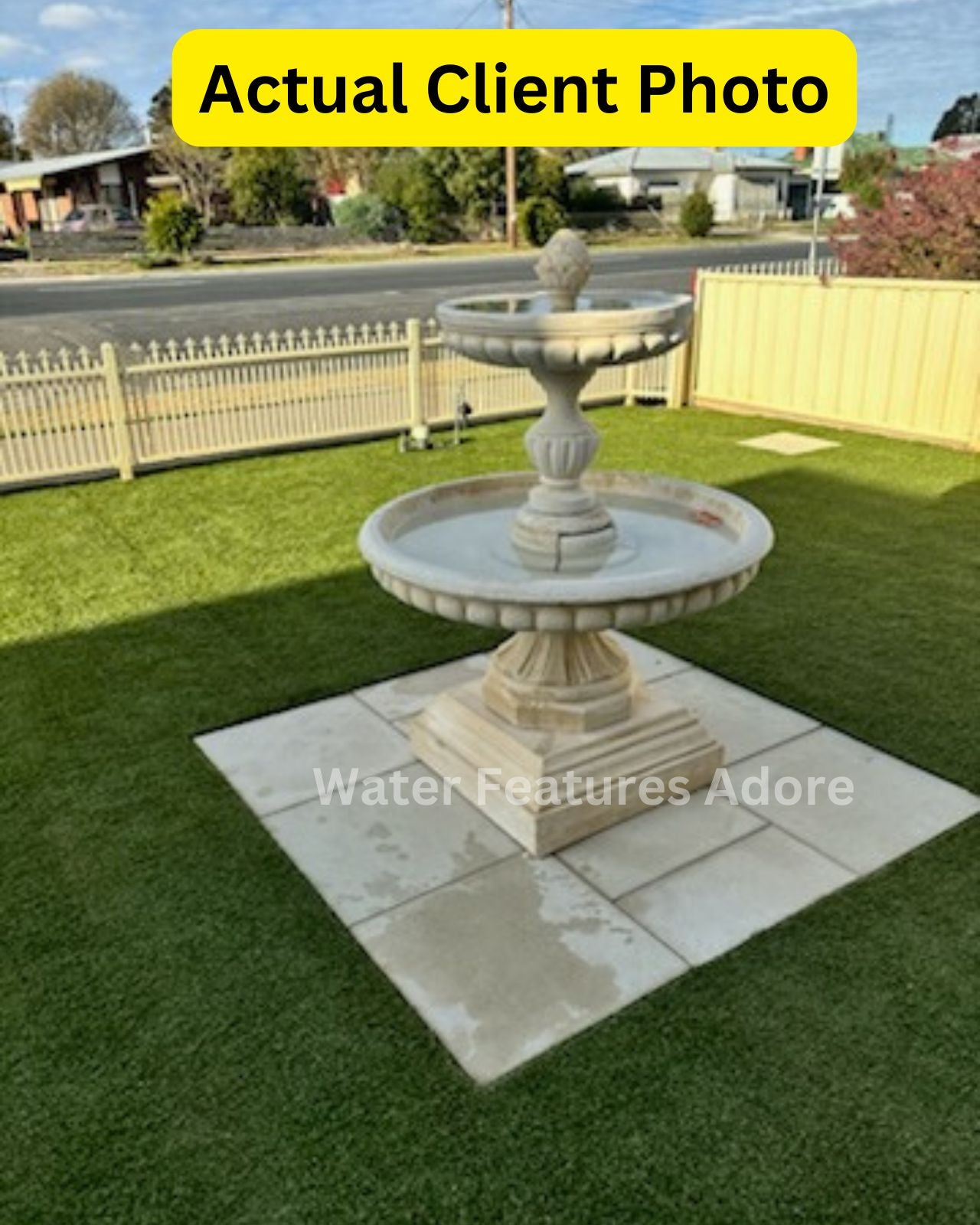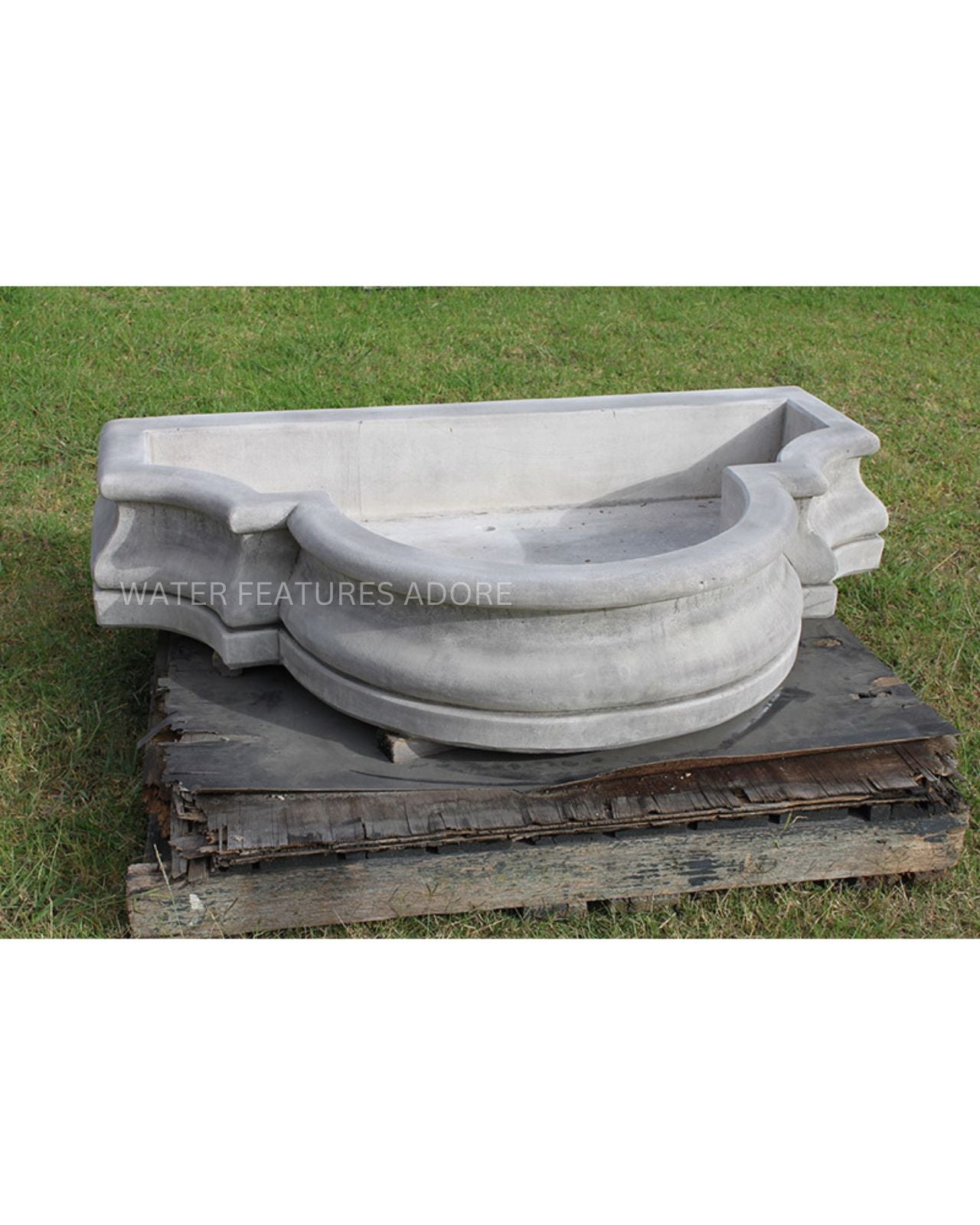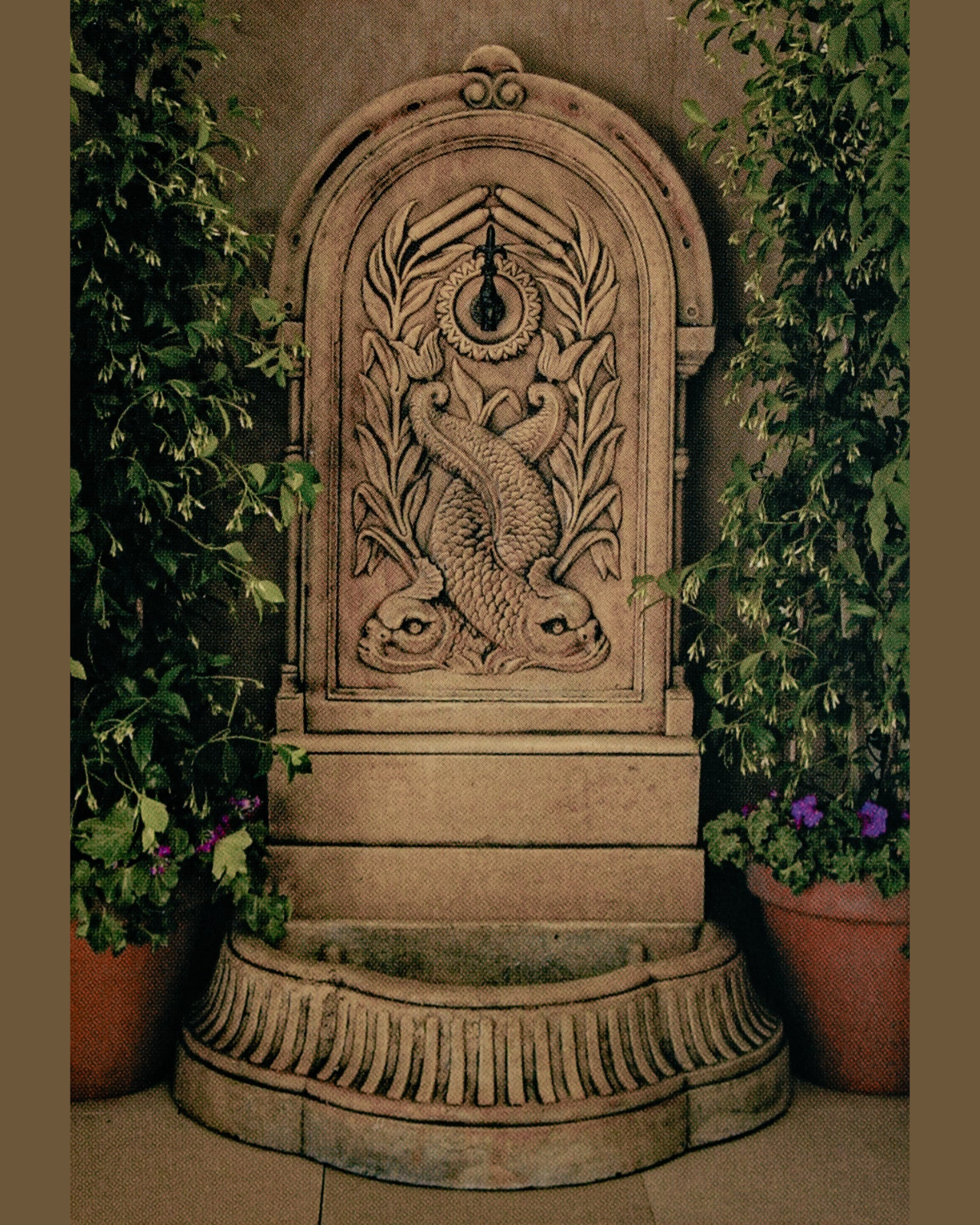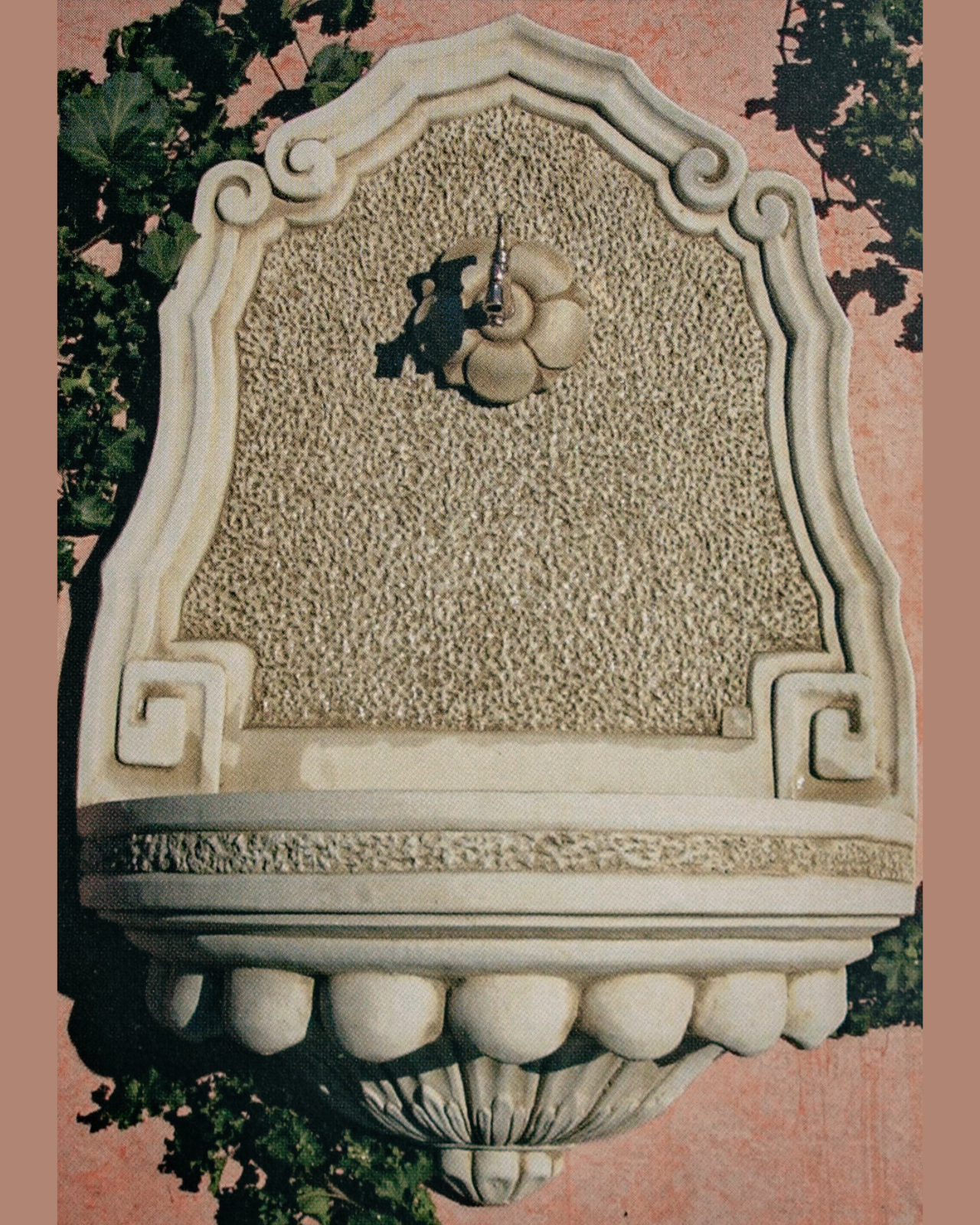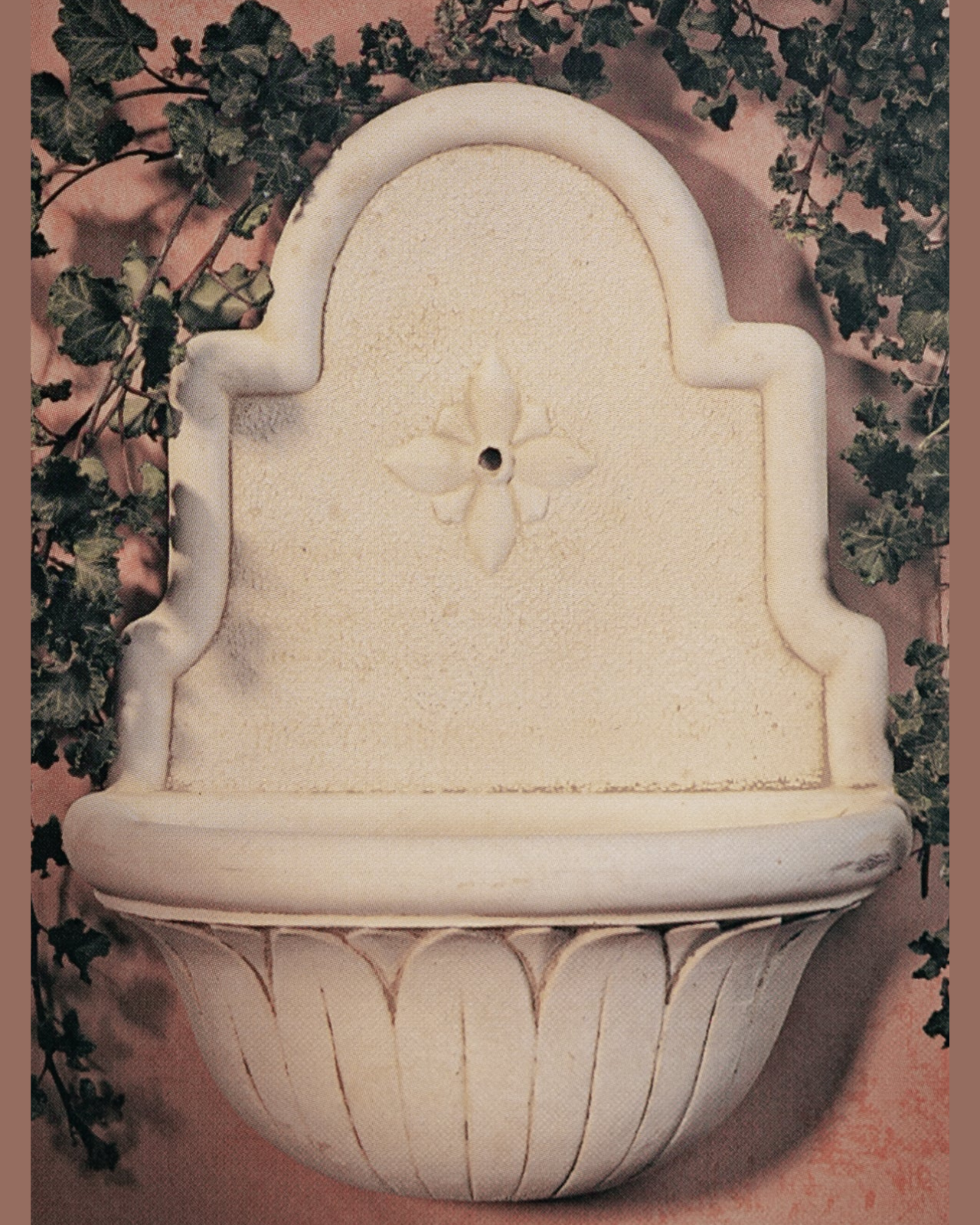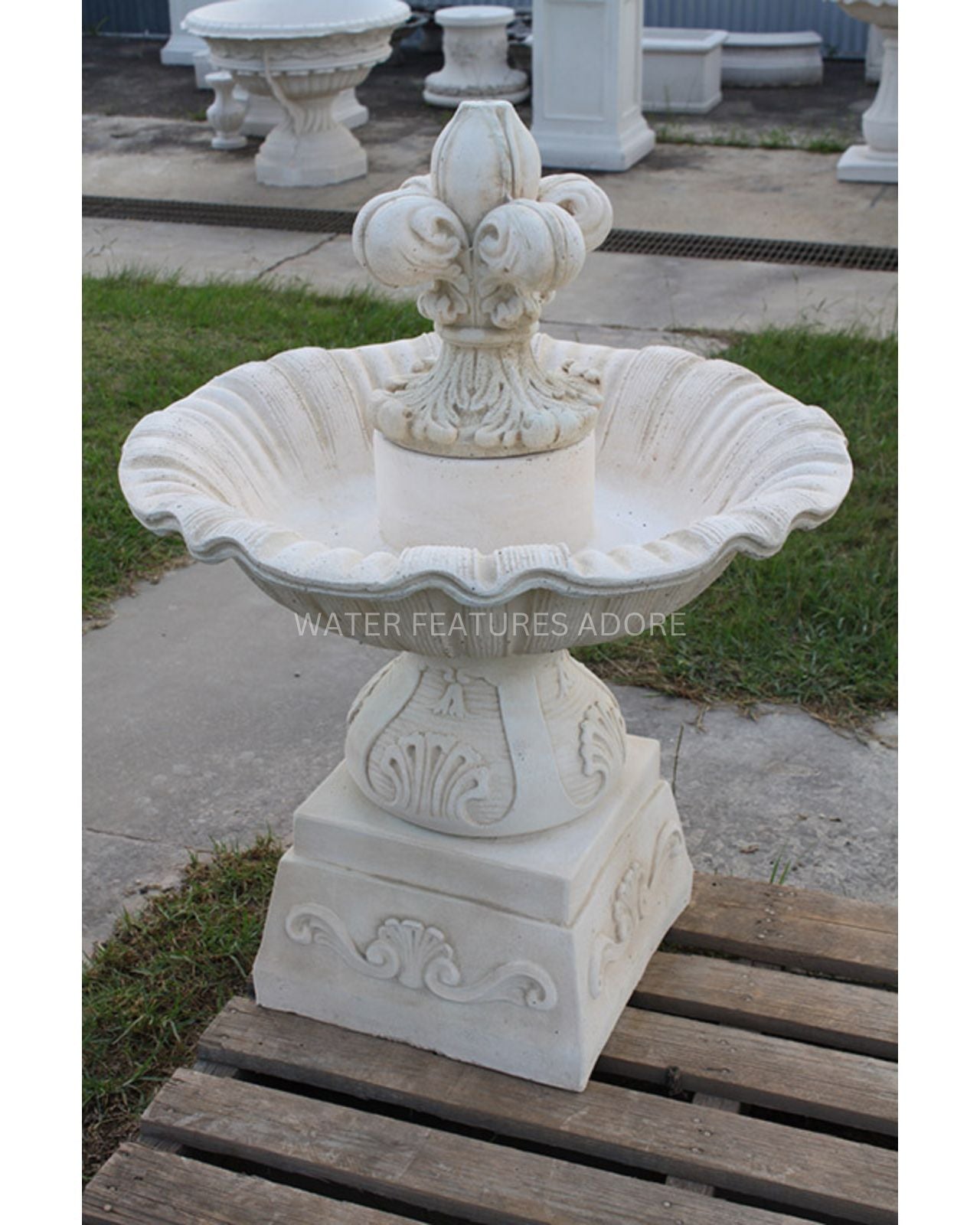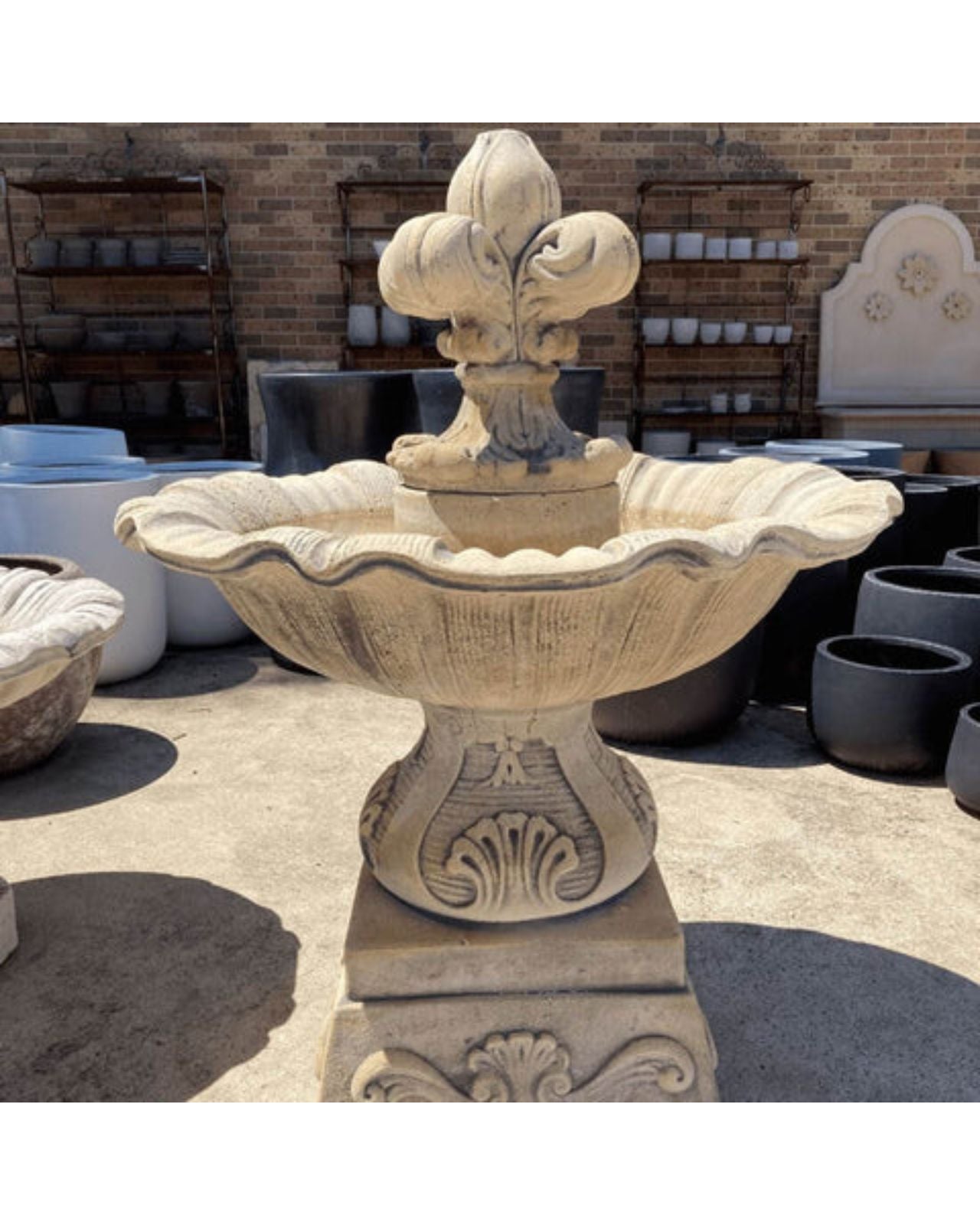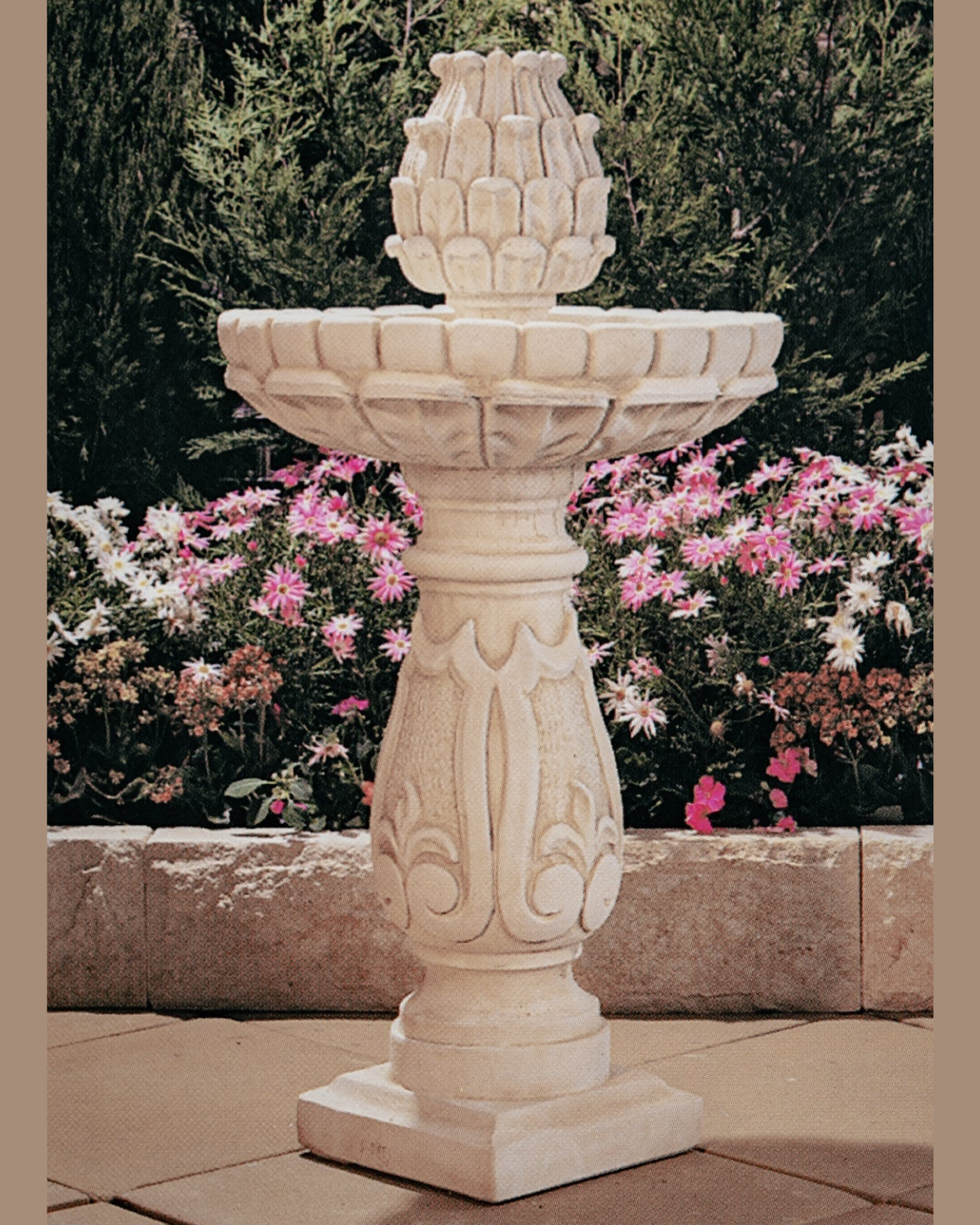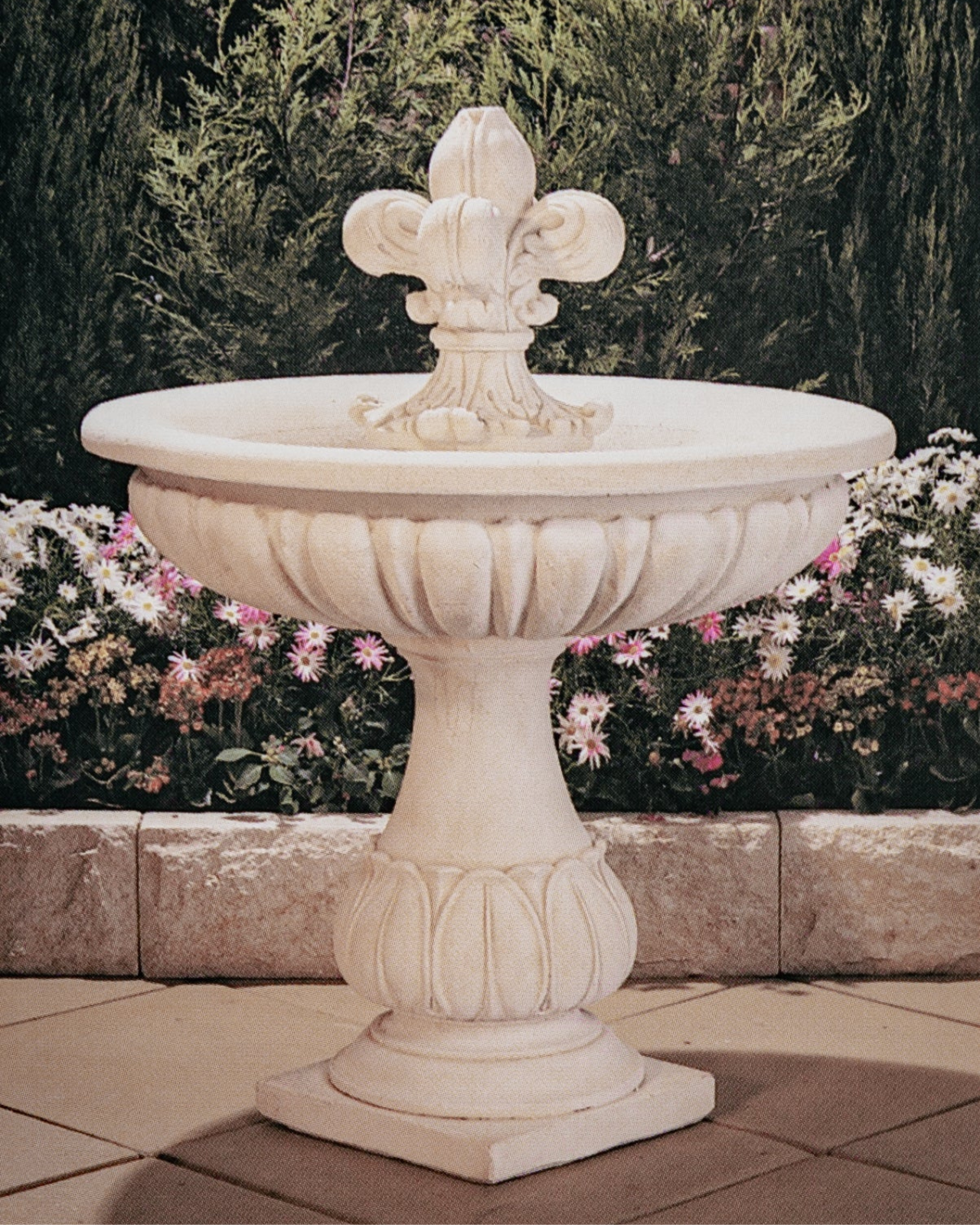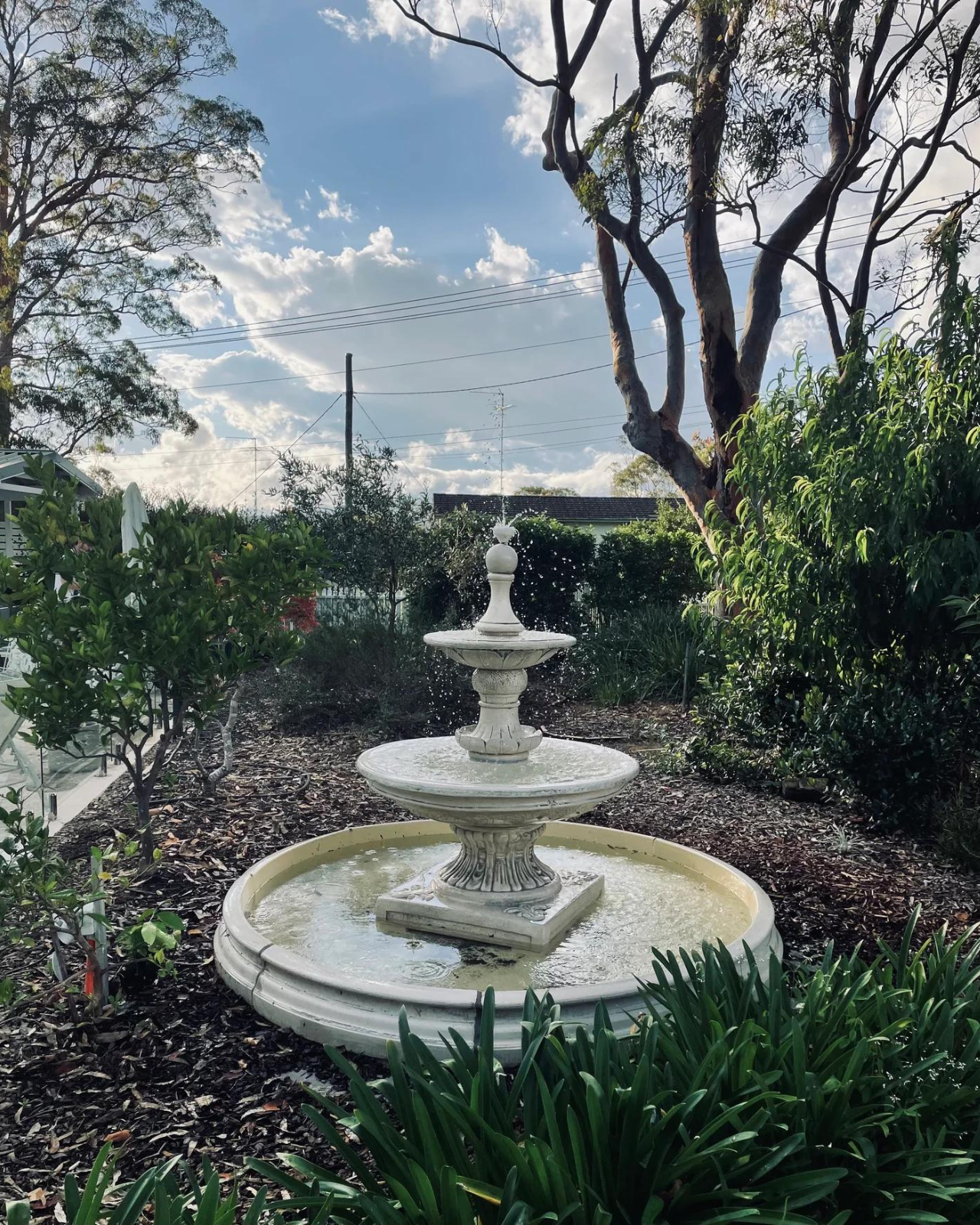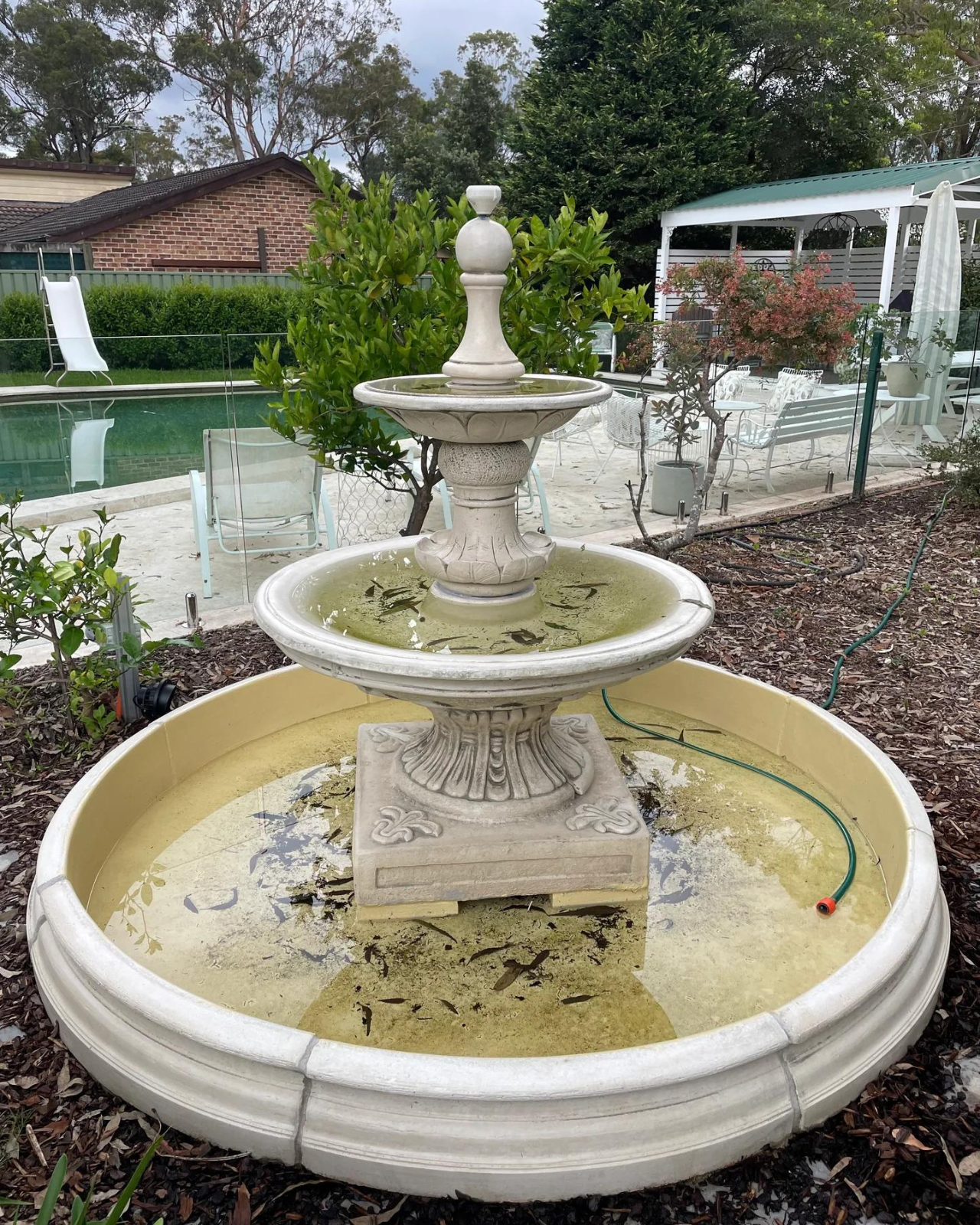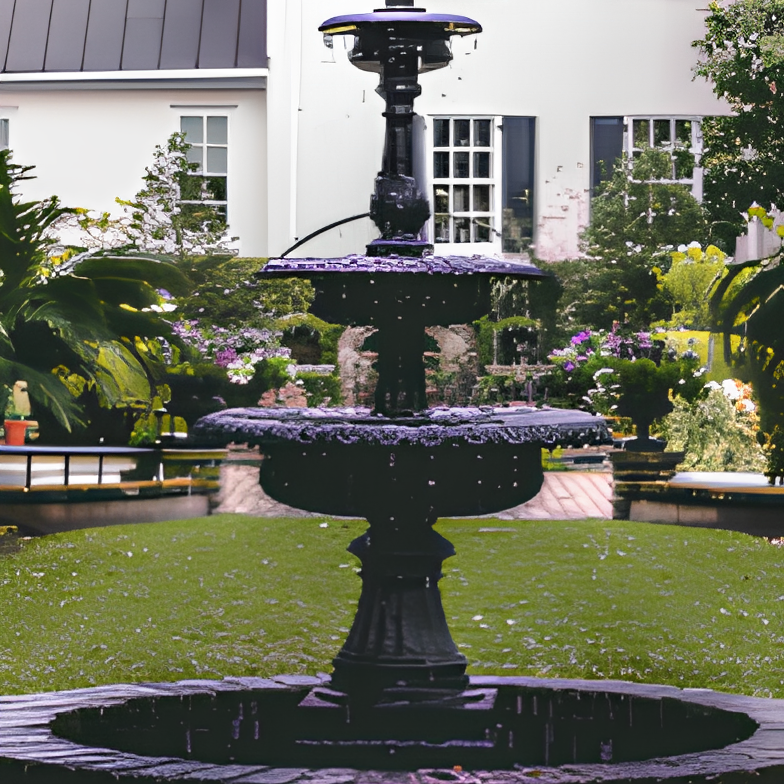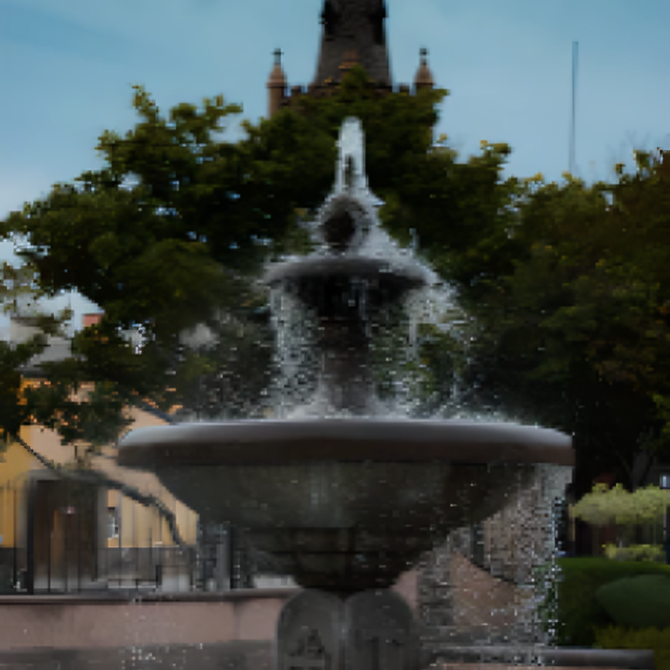Revitalize your outdoor environment with our exclusive assortment of concrete cement water fountains. At Water Features Adore, we value the everlasting allure and flexibility of cement, harmoniously blended with materials such as limestone and marble chip, to craft water features that range from grand to intimate.
Introduction
Definition of Concrete Cement Water Fountains
Concrete cement water fountains are artistic and functional water features crafted from a mixture of cement, sandstone, limestone, and sometimes marble chips. These fountains serve as a focal point in a garden, backyard, or any landscaped area, adding both aesthetic appeal and a soothing ambiance. The amalgamation of these materials results in a durable and versatile structure, capable of withstanding various environmental conditions while offering a plethora of design possibilities.
Brief History and Evolution
The inception of concrete water fountains can be traced back to ancient civilizations, where they were used to provide water for communities and serve as communal gathering spots. Initially, materials like limestone and marble were predominantly used, given their availability and the aesthetic appeal they offered. As societies evolved, the integration of cement allowed for enhanced durability and more intricate designs, making these fountains a popular water feature in both public spaces and private gardens.
The evolution of concrete cement water fountains has seen them transform from simple, functional structures to elaborate pieces of art. The incorporation of different materials like sandstone and marble chips has allowed for a variety of textures and finishes, enabling these fountains to mimic the natural beauty of a waterfall within a controlled environment.
Importance and Usage in Landscaping
Concrete cement water fountains have become a cornerstone in landscaping, often used to elevate the aesthetic of gardens, backyards, and public spaces. Their importance lies in their ability to create a tranquil atmosphere, the sound of flowing water adding a serene element to any environment. These fountains serve as a dynamic water feature, their designs ranging from wall-mounted structures to standalone pieces, each adding a unique charm to the landscape.
In addition to their aesthetic appeal, concrete water fountains play a pivotal role in enhancing the biodiversity of a garden. They attract various fauna, such as birds and insects, promoting a balanced ecosystem within the backyard. The versatility of materials like cement, sandstone, limestone, and marble chips allows for customization, enabling these fountains to complement different architectural styles and landscape designs.
In conclusion, concrete cement water fountains, with their rich history and evolution, have become an integral water feature in landscaping. Their versatility in design, coupled with the durability of materials like cement and limestone, make them a popular choice for enhancing the beauty and tranquility of gardens, backyards, and various outdoor spaces.
Types of Concrete Cement Water Fountains
A. Wall Fountains
Description and Design
Wall fountains are a type of concrete water fountain that are mounted or attached to a wall. They are typically designed with materials such as cement, sandstone, limestone, and marble chip, which contribute to their aesthetic appeal and durability. The water in these fountains usually flows down a flat surface, creating a sheet-like waterfall effect, which can be particularly calming and visually appealing.
Common Uses and Placement
Wall fountains are versatile water features that are commonly used in both indoor and outdoor settings. In outdoor landscapes, they are often placed in gardens, backyards, and patios, where they serve as a focal point and add a sense of tranquility. Indoors, they are used to enhance the ambiance of a room and introduce a natural element to the space.
B. Tiered Fountains
Description and Design
Tiered fountains are characterized by multiple levels or “tiers” through which water cascades down. These fountains are typically made of concrete and cement, often incorporating sandstone, limestone, or marble chip for added texture and visual interest. The design of tiered fountains can range from simple and classic to elaborate and ornate, making them a versatile option for various settings.
Common Uses and Placement
Tiered fountains are a popular choice for central garden features, public squares, and courtyards. Their grand and often symmetrical design makes them a focal point in any setting, drawing attention and inviting interaction. The sound of cascading water adds a soothing ambiance, making them a favored addition to both private and public outdoor spaces.
C. Bubbling Fountains
Description and Design
Bubbling fountains feature water bubbling out from a single point, often from a stone or a sculpture, creating a gentle and calming sound. These fountains are usually constructed using cement and concrete, with the option of incorporating materials like sandstone, limestone, and marble chip for a varied appearance. Bubbling fountains are known for their simplicity and understated elegance.
Common Uses and Placement
Bubbling fountains are versatile and can be placed in a variety of settings, including gardens, backyards, and patios. They are ideal for smaller spaces due to their compact design and are often used to create a peaceful corner in a landscape. Additionally, they are a popular choice for adding a water element to indoor spaces, such as entryways and living rooms.
D. Cascading Fountains
Description and Design
Cascading fountains are designed with multiple, uneven levels, allowing water to “cascade” down in a more natural and irregular waterfall pattern. These fountains are typically constructed with concrete and cement, and they may feature sandstone, limestone, and marble chip accents. The design of cascading fountains mimics the beauty and randomness of natural waterfalls, making them a picturesque addition to any space.
Common Uses and Placement
Cascading fountains are commonly used in gardens and backyards to create a natural and organic feel. They are often placed near plants and flowers to enhance the overall landscape and attract local wildlife. The irregular flow of water in cascading fountains makes them a captivating and dynamic water feature, suitable for both residential and commercial landscapes.
Material Insights: Concrete and Cement
A. Composition of Concrete and Cement
Concrete and cement are fundamental materials used in constructing a concrete water fountain. Cement acts as a binder, typically composed of limestone, clay, shells, and silica. When mixed with water, it forms a paste that binds with sandstone, limestone, marble chip, and other aggregates to harden into concrete. This composition results in a robust and durable material, ideal for creating lasting water features in any garden or backyard.
B. Benefits of Using Concrete Cement for Water Fountains
Durability
One of the primary benefits of using concrete and cement for water fountains is their exceptional durability. These materials withstand various weather conditions, ensuring that the waterfall feature remains intact and functional for years. The resilience of concrete makes it an ideal choice for outdoor water features, where it is exposed to the elements.
Versatility in Design
Concrete cement offers unparalleled versatility in design. It can be molded into various shapes and sizes, allowing for a wide range of water fountain designs, from wall fountains to cascading structures. The addition of materials like sandstone, limestone, and marble chip further enhances the aesthetic appeal, enabling customization to suit different landscapes and architectural styles.
Cost-Effectiveness
Concrete water fountains are a cost-effective option for those looking to add a water feature to their garden or backyard. The materials used, such as cement, sandstone, and limestone, are generally more affordable compared to other alternatives. Additionally, the longevity and low maintenance requirements of concrete fountains contribute to their overall cost-effectiveness.
C. Potential Drawbacks and Solutions
Weight
One of the drawbacks of using concrete and cement in water fountains is the significant weight of the materials. This can pose challenges in transportation and installation. However, this issue can be mitigated by constructing the fountain in sections or opting for a smaller design, ensuring easier handling and placement in the desired location.
Porosity and Sealing
Concrete is inherently porous, which means it can absorb water and other substances, potentially leading to damage over time. To address this, concrete water fountains should be properly sealed. Sealing not only protects the concrete from water absorption but also enhances the longevity of the water feature, ensuring that it remains a centerpiece in the garden or backyard for years to come.
Designing and Customizing Concrete Cement Water Fountains
A. Design Considerations
Size and Scale
When designing a concrete water fountain, it is essential to consider the size and scale of the feature in relation to its surroundings. The fountain should be proportionate to the available space in the garden or backyard, ensuring it complements rather than overwhelms the landscape. The scale of the fountain will also impact the waterfall effect and sound, contributing to the overall ambiance of the area.
Style and Aesthetics
The style and aesthetics of the concrete water fountain should align with the overall theme and design of the landscape or architectural setting. Whether incorporating sandstone, limestone, or marble chip, the materials and design elements chosen should harmonize with the existing environment. Consideration of whether the fountain will be a wall feature or a standalone piece will also influence the style and aesthetic outcome.
Water Flow and Sound
The design of the water feature should take into account the desired water flow and sound. The flow of the waterfall can be adjusted to create a tranquil trickle or a more pronounced cascade, depending on the preference. The sound of flowing water contributes to the sensory experience, enhancing the calming and serene atmosphere of the garden or backyard.
B. Customization Options
Color and Texture
Concrete and cement offer a versatile canvas for customization in terms of color and texture. The natural tones of sandstone and limestone can be complemented by adding pigments to the concrete mix, allowing for a range of color options. Textural variations can be achieved by incorporating materials like marble chip, creating a unique and visually appealing surface for the water fountain.
Incorporating Art and Sculptures
Artistic elements and sculptures can be integrated into the design of the concrete water fountain to enhance its visual appeal and create a focal point in the garden or backyard. Whether it’s a classical statue or a modern abstract piece, incorporating art adds a layer of sophistication and personalization to the water feature.
Adding Lighting and Other Features
To elevate the ambiance of the concrete water fountain, consider adding lighting and other features. Strategically placed lights can highlight the waterfall and the texture of the cement, sandstone, and limestone, creating a captivating visual effect. Other features such as seating areas and surrounding plants can further enhance the overall design and functionality of the water fountain in the landscape.
Installation Process
Selecting the Right Location
Choosing the right location is paramount when installing a concrete water fountain. The location should complement the overall landscape of the garden or backyard and should be visible and accessible. Consideration of the fountain’s proximity to a water supply and electrical outlets is also essential. The chosen spot should not only highlight the waterfall feature but also ensure that the fountain integrates seamlessly with the surrounding environment.
Preparing the Foundation
Once the location is finalized, preparing a solid foundation is the next step. The foundation must be level and stable to support the weight of the concrete and cement structure. Depending on the design, additional materials like sandstone, limestone, or marble chip may be incorporated, which can also influence the foundation requirements. A well-prepared foundation is crucial to prevent any future shifting or damage to the water feature.
Assembling and Installing the Fountain
The assembly and installation of the concrete water fountain involve placing the various components together and securing them in place. This process may vary depending on whether the fountain is a wall feature or a standalone structure. Careful handling of the materials is necessary to avoid any damage to the cement, sandstone, limestone, or marble chip elements. Following the manufacturer’s instructions or consulting with a professional installer can ensure a smooth and successful installation.
Connecting Water Supply and Electricals
After the fountain is assembled and installed, connecting it to a water supply and electricals is the final step. This involves attaching the pump, which circulates the water to create the waterfall effect, and connecting any lighting or additional features. Properly securing the electrical connections is vital for safety, especially in an outdoor setting like a garden or backyard. Once connected, the concrete water fountain is ready to be enjoyed, adding a tranquil and aesthetic element to the landscape.
Maintenance and Care
Cleaning and Algae Prevention
Maintaining a clean concrete water fountain is essential for its longevity and aesthetic appeal. Algae growth is a common issue, especially in outdoor water features located in gardens and backyards. Regular cleaning and the use of algae prevention products can help maintain the clarity of the waterfall and the overall appearance of the fountain. Paying attention to areas made of sandstone, limestone, or marble chip is crucial, as these materials can be more susceptible to algae and dirt accumulation.
Winterizing and Protecting from Freeze-Thaw Cycles
Concrete water fountains made of cement and other materials need protection from freeze-thaw cycles, especially in regions with harsh winters. Winterizing involves draining the fountain, protecting the surface with covers, and possibly storing smaller components indoors. This process helps prevent water from freezing and expanding within the fountain, which could lead to cracks and damage to the cement, sandstone, limestone, and marble chip components.
Repairing Cracks and Surface Damage
Over time, concrete water fountains may develop cracks or surface damage due to weathering or wear and tear. Promptly addressing these issues is essential to prevent further deterioration. Repairing cracks involves cleaning the damaged area, applying a suitable repair compound, and allowing it to cure. Regular inspection of the water feature, especially the wall and base, can help identify and rectify any damage early, ensuring the fountain remains a centerpiece in the garden or backyard.
D. Maintaining Water Quality and Pump Functionality
Ensuring good water quality and pump functionality is vital for the operation of any concrete water fountain. Regularly checking and adjusting the water levels, cleaning the pump filter, and monitoring the water quality can prevent issues such as blockages and poor water circulation. Maintaining the pump in optimal condition ensures a consistent waterfall effect and contributes to the serene ambiance of the water feature in the landscape.
Environmental Considerations
Water Usage and Conservation
While concrete water fountains add aesthetic and tranquil elements to a garden or backyard, it is essential to consider their water usage. Fountains, by design, circulate water to create a waterfall effect, but evaporation and splashing can lead to water loss. Implementing water conservation measures, such as using a submersible pump to recirculate water and regularly checking for leaks, can help minimize water wastage and maintain the sustainability of the water feature.
Sustainable Practices and Materials
In constructing concrete water fountains, the choice of materials and building practices can significantly impact sustainability. Opting for eco-friendly and sustainably sourced materials like cement, sandstone, limestone, and marble chip can reduce the environmental footprint of the fountain. Additionally, incorporating sustainable practices, such as using energy-efficient pumps and LED lights, contributes to the overall eco-friendliness of the water feature in the garden or backyard.
Impact on Local Ecosystems
The introduction of a concrete water fountain in a garden or backyard can have varying effects on local ecosystems. On the one hand, the water feature can attract wildlife such as birds and insects, promoting biodiversity and enhancing the natural balance of the area. However, it is crucial to monitor the water quality and ensure that the fountain does not become a breeding ground for pests. Balancing the benefits and potential impacts requires careful consideration and responsible maintenance of the waterfall and surrounding environment.
Cost and Budgeting
Factors Influencing Cost
Several factors can influence the cost of a concrete water fountain. The choice of materials such as cement, sandstone, limestone, and marble chip can significantly impact the overall price, with some materials being more costly than others. The size and scale of the water feature, as well as the complexity of the design, also play a crucial role in determining the cost. Additionally, the location of the fountain, whether it is a wall feature or a standalone piece in a garden or backyard, can affect installation costs.
Budgeting for Installation and Maintenance
When planning for a concrete water fountain, it is essential to budget not only for the initial installation but also for ongoing maintenance. Installation costs will include the price of materials, labor, and any additional features such as lighting. Maintenance budgeting should account for regular cleaning, potential repairs, and winterizing procedures to protect the waterfall feature from freeze-thaw cycles. Proper budgeting ensures the longevity and aesthetic appeal of the fountain in the landscape.
Cost-Effective Alternatives and DIY Options
For those working with a tighter budget, cost-effective alternatives and DIY options are available. Pre-cast concrete water fountains can be a more affordable choice compared to custom designs. Additionally, incorporating less expensive materials while still maintaining the aesthetic appeal of sandstone, limestone, or marble chip can also be considered. DIY enthusiasts may explore building their own water feature, utilizing online resources and tutorials, which can significantly reduce labor costs and allow for personalized customization of the fountain in the garden or backyard.
Future Trends and Developments
The world of concrete water fountains is ever-evolving, with new trends and developments continually shaping the landscape of water features. As we look to the future, several key trends are emerging that blend innovation with sustainability and aesthetic appeal.
Sustainable Materials and Practices:
The growing emphasis on sustainability is driving the use of eco-friendly materials such as recycled cement and sustainably sourced sandstone, limestone, and marble chip. These materials not only reduce the environmental impact of concrete water fountains but also offer unique textures and finishes, enhancing the aesthetic diversity of water features in gardens and backyards.
Smart Technology Integration:
The integration of smart technology into concrete water fountains is a notable trend. Automated lighting, water flow control, and energy-efficient pumps are becoming standard features. These technologies allow for customization of the waterfall experience, optimizing energy usage, and enhancing the ambiance of the garden or backyard setting.
Personalized and Artistic Designs:
The demand for personalized and artistic water features is on the rise. Custom designs that incorporate elements of art, unique wall textures, and bespoke shapes are becoming increasingly popular. The versatility of concrete and cement allows for intricate designs and the incorporation of various materials like sandstone, limestone, and marble chip, enabling homeowners to create a truly unique focal point in their outdoor spaces.
Compact and Modular Features:
As urban living spaces become more compact, there is a growing trend towards smaller, modular concrete water fountains. These fountains are designed to fit into limited spaces, offering the tranquility of a water feature without requiring a large garden or backyard. Modular designs also allow for easy installation and adaptability, catering to the changing needs of urban dwellers.
Ecological and Biodiversity Enhancement:
Future developments in concrete water fountain design are likely to focus on enhancing local ecosystems and promoting biodiversity. Fountains that attract wildlife, support plant growth, and contribute to the ecological balance of a garden or backyard are gaining popularity. This trend aligns with a broader shift towards environmentally conscious landscaping and garden design.
The future of concrete water fountains is poised to be diverse and innovative, blending sustainability with technology and artistic expression. These developments will continue to enhance the appeal of water features, making them a timeless addition to gardens, backyards, and outdoor spaces.
Concrete Cement Water Fountains in the Australian Context
In the diverse landscapes of Australia, spanning from the bustling streets of Sydney and Melbourne to the serene environments of Adelaide and Hobart, Concrete Cement Water Fountains have found a harmonious place. These water features are not just aesthetic additions but also functional elements that enhance the tranquility of outdoor spaces across the major cities.
In Sydney and Melbourne, where urban green spaces are cherished, these fountains serve as focal points in both public parks and private gardens, adding a touch of nature to the urban jungle. Brisbane, with its warm, subtropical climate, welcomes these water features as cooling elements, providing a refreshing oasis in the city’s landscape.
Adelaide and Perth, known for their drier climates, value Concrete Cement Water Fountains for their ability to introduce a sense of freshness and calm to the surroundings. In Canberra, the nation’s capital, these fountains contribute significantly to the aesthetic appeal of the city’s meticulously planned urban landscape.
Hobart, a city rich in heritage, incorporates these fountains in various settings, reflecting a blend of historical charm and contemporary lifestyle. Regardless of the city, the adaptability and versatility of Concrete Cement Water Fountains make them a popular choice for enhancing outdoor spaces, proving their significance in the Australian context.
Browse Our Collection of Concrete Cement Water Fountains
At Water Features Adore, we are delighted to present a diverse collection of Concrete Cement Water Fountains, each uniquely crafted to transform your outdoor spaces into tranquil havens. Our assortment is meticulously curated to cater to a variety of tastes and preferences, ensuring that every customer finds a water feature that resonates with their style and aesthetic.
Tiered Concrete Cement Water Fountains
Discover the elegance of our Tiered Concrete Cement Water Fountains, available in a variety of designs including 1 Tier, 2 Tier, 3 Tier, and 4 Tier options. Each tier adds a layer of complexity and beauty, creating a cascading effect that is visually appealing and soothing to the senses. These fountains are a timeless choice for those looking to add a touch of grandeur to their gardens or backyards.
Concrete Cement Water Fountains with Kids
Our collection also features charming Concrete Cement Water Fountains with Kids. These playful designs depict children in various poses, adding a whimsical and joyful element to your outdoor space. They are perfect for creating a family-friendly atmosphere and are sure to bring smiles to faces, young and old.
Umbrella Cement Water Fountains
Step into a world of enchantment with our Umbrella Cement Water Fountains. These fountains feature intricate designs of figures holding umbrellas, under which water gracefully flows. The umbrella theme introduces a romantic and nostalgic feel, making these fountains a delightful addition to any setting.
Lady Cement Water Fountains
Elegance and grace define our collection of Lady Cement Water Fountains. These fountains portray beautiful lady statues, adding a touch of femininity and sophistication to your garden or backyard. The serene flow of water complements the elegant designs, creating a peaceful and inviting ambiance.
Lion Cement Water Fountains
For those seeking a bold and regal statement, our Lion Cement Water Fountains are the ideal choice. The lion motifs symbolize strength and majesty, making these fountains a commanding presence in any outdoor space. The roar of the water combined with the majestic lion designs offers a unique and powerful aesthetic.
Wall Concrete Cement Water Fountains
Maximize your space with our Wall Concrete Cement Water Fountains. These fountains are designed to be mounted on walls, making them a versatile option for smaller gardens or patios. Despite their compact design, they create a significant impact, turning any wall into a dynamic and soothing water feature.
Water Fountain Ponds
Lastly, explore the tranquility of our Concrete Water Fountain Ponds. These features combine the beauty of a fountain with the calmness of a pond, creating a harmonious water element that enhances the biodiversity of your garden. They are a wonderful option for those looking to create a natural and serene environment.




